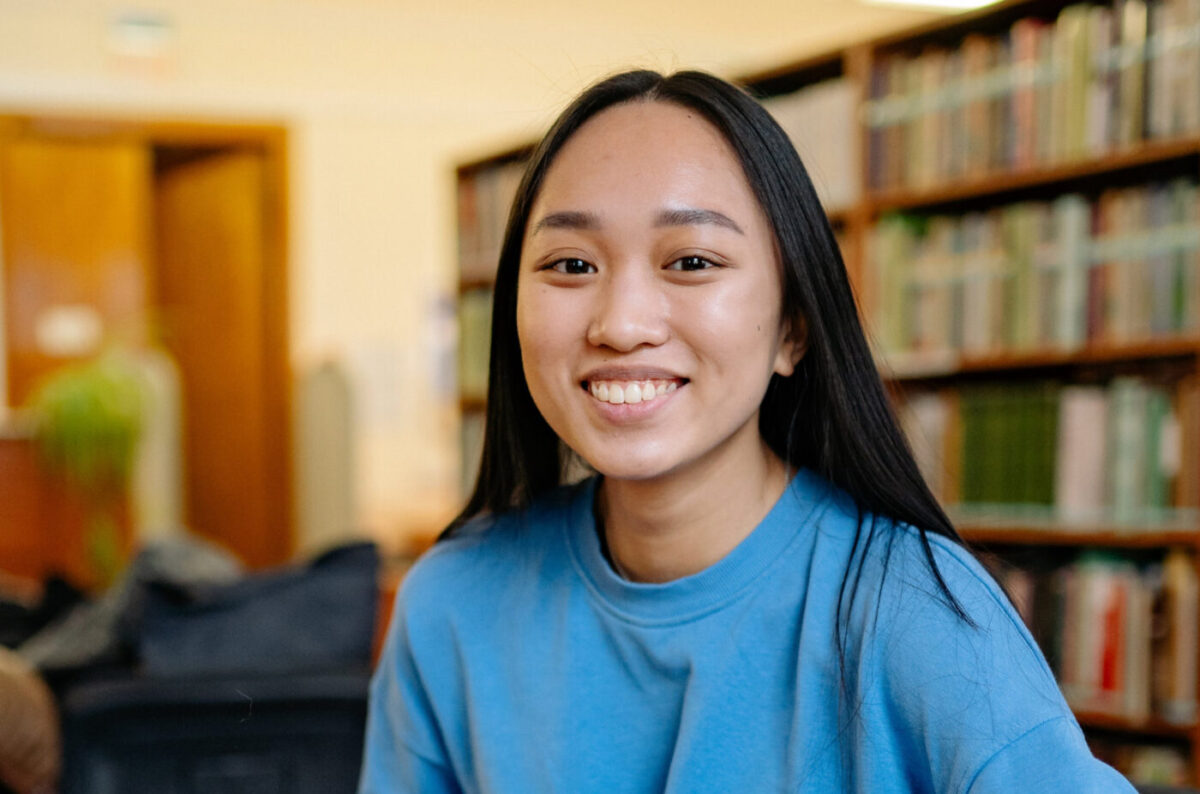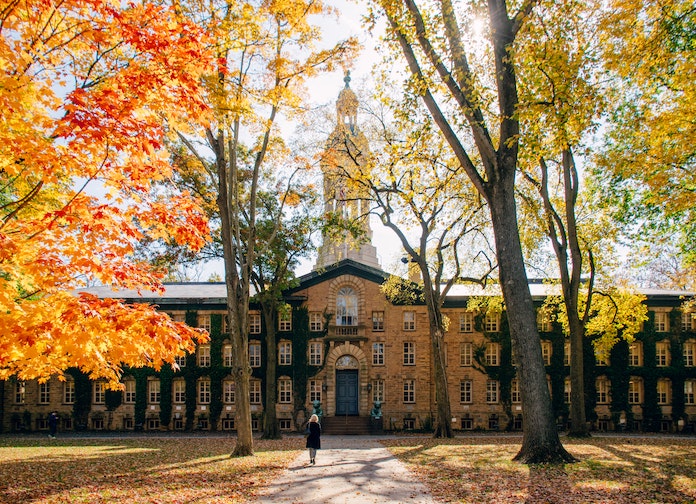In spring of 2022 Princeton announced that, for the first time in recent history, they would not be releasing admissions data on the pool of applicants to the Class of 2026. Instead, they provided an info sheet on the University website that focuses on the matriculating class. What we know: a total of 1,500 students enrolled in the Class of 2026 – the largest class ever. Of these students, 51% are female, 49% are male, and 17% are first-generation college students. The class represents 48 U.S. states (all except Maine and Alaska) and 76 countries abroad.
Based on application numbers pulled from the past decade, we can estimate that the number of enrolled students represents between 3.99% and 5.66% of total applicants from the 2026 admissions cycle (for the last decade, applicant numbers have ranged between 26,498 and 37,601 students). As a measure of comparison, the Class of 2025 admissions cycle saw 1,647 students admitted for an overall acceptance rate of 4.38%, and, of these, 1,345, or 3.58% of total applicants, enrolled. As mentioned, the Class of 2026 is the largest ever at Princeton; it is worth noting that the 2021-22 admissions cycle was the first year in a four-year strategic planning process aimed at expanding the undergraduate student body. The university has planned room for an additional 125 undergraduates per year, with an even broader expansion of the undergraduate student body planned in the future.
PRINCETON ACCEPTANCE RATE: DRIVING FORCES
Test-optional policies brought about by the COVID-19 pandemic account for the highly competitive 2020-21 admissions cycle. Princeton announced its test-optional policy in the summer of 2020 and has since renewed the policy into the 2022-23 admissions cycle (for admission to the Class of 2027). While other Ivies (including Harvard and Cornell) have already extended similar policies for years to come, Princeton has refrained from doing so.
At Princeton, the influx of applicants in the 2020-21 admissions cycle was remarkable, sitting at a 14.51% increase over the previous year. However, other Ivies witnessed an even more impressive influx: Harvard saw a 42.70% increase in applications between the 2019-20 and 2020-21 admission cycles, Columbia saw a 51.06% increase, and Yale a 34.13% increase. The fact remains that Princeton has long been among the most competitive Ivies: while the acceptance rate for the highly-competitive Class of 2025 was 4.38%, previous years were only ever so slightly higher, at 5.63% (Class of ‘24), 5.78% (‘23), and 5.49% (‘22). The past decade has seen a general decline in acceptance rates, with an acceptance rate for the Class of 2016 of 8.63%.

Essay Guidance
Get our expert guidance on your college essays.
HOW TO INCREASE YOUR ODDS AT PRINCETON
Know What Makes Princeton Unique
Don’t apply to Princeton just because you want to attend an Ivy League school; apply because of how your interests and goals align with the mission of the school and its academic offerings. Princeton is different from Cornell, which is different from the University of Pennsylvania, which is different from Yale. It’s your job to ensure that your application speaks to the school to which you’re applying. So, what is Princeton all about?
“Princeton University has a longstanding commitment to service, reflected in Princeton’s informal motto — Princeton in the nation’s service and the service of humanity — and exemplified by the extraordinary contributions that Princetonians make to society” (President Christopher L. Eisgruber). Indeed, with its many service-oriented initiatives, including the pre-orientation Community Action program, Bridge Year program, and the Venture Forward fundraising and engagement campaign that aims to “encourage a spirit of service to the University and to humanity,” among others, the University has made it clear the sorts of service-oriented, humanity-minded students that it aims to support with its world-class resources.
Even Princeton’s supplemental essay questions aim to get to know students from this angle: Princeton has a longstanding commitment to service and civic engagement. Tell us how your story intersects (or will intersect) with these ideals. Another: At Princeton, we value diverse perspectives and the ability to have respectful dialogue about difficult issues. Share a time when you had a conversation with a person or a group of people about a difficult topic. What insight did you gain, and how would you incorporate that knowledge into your thinking in the future?
Before you apply to Princeton, consider how your interests intersect with your position as a steward of humanity. If you can’t answer this question, maybe Princeton’s not the right school for you – and that’s okay! But take some time to think about it. This may be a new way of looking at the things you enjoy, and you might be surprised by what the question brings up for you!
UNDERSTAND THE NUMBERS
Early versus Regular Decision Acceptance Rates
Princeton’s Single-Choice Early Action program has historically been a great way to increase your odds of getting into the school. Due to the disruptions of the pandemic, the University suspended its Early Action program for the 2020-21 admissions cycle. In 2021-22, however, the policy was reinstated. Although the University has not released data on acceptance rates for early applicants in this cycle, we do know that of the 1,848 students admitted to the Class of 2024, 791 were Early Action admits. The EA acceptance rate that year was 15.82%, a number that is similar to EA acceptance rates for the Class of ‘23 (13.93%) and ‘22 (14.79%). Contrast this with Princeton’s regular decision acceptance rates of 3.71%, 4.19%, and 3.89% for the Classes of ’24, ’23, and ’22 respectively and it’s clear EA applicants have the advantage. Moreover, the Classes of ’23 and ’22 were filled 57.15% and 61.46%, respectively, by early admissions.
Princeton’s Early Action program is “Single-Choice,” meaning students may not apply early to any other private college or university but may apply early to a public institution, so long as the decision is non-binding. Basically, if Princeton is your top choice and you want to increase your odds, apply early. You can always change your mind about the best school for you, which is not the case for binding Early Decision programs (which also often increase your odds by a larger margin).
THE DATA ON “HOOKS”
Of the 1,500 enrolled students in the Class of 2026, 10% are children of Princeton alumni, AKA legacy admits. Additionally, 9% of the class self-identify as Black or African American, 8% as Hispanic or Latino/a/x, 7% as Multiracial, and less than 1% as Native American, Hawaiian American or Pacific Islander. Colleges across the board have been working to increase the diversity of their class composition, and these underrepresented minority (URM) students have an admissions “hook”: they’ll have a competitive advantage if their test scores, GPA, and class rank are in range of a school. In the Class of 2026, 17% of students are the first in their families to go to college, also an admissions hook. It is important to note that we do not know the overlap between hooks, meaning it is unclear how many URMs are also first-gen.
Over two decades ago, Princeton became the first university in the country to remove loans from its financial aid. Beginning in Fall ’23, Princeton financial aid will cover tuition, room, and board for students from families making less than $100,000 per year, meaning these students will attend Princeton for free. The data backs up this initiative: 61% of the class qualify for financial aid, and 21% of the class are eligible for federal Pell Grants.
ACADEMIC PROFILE OF ADMITTED STUDENTS
Contrary to popular belief, students graduating from public schools have a statistical advantage over their private school peers. 60% of the Class of 2026 comes from public secondary schools, 17% from independent day schools, 13% from religiously-affiliated schools, 14% from non-U.S. schools, and 9% from independent boarding schools. The remainder were either home-schooled or attended military schools.
Despite the current test-optional admissions policy, students continued to submit highly-competitive scores across the board. The middle 50% of the Class of 2026 scored 1490-1580 on the SAT and 33-35 on the ACT composite. Testing averages have increased everywhere, which makes sense since students who score well report their scores, while those with weaker scores do not.
When deciding where to go for college, it’s helpful to know how students on campus spend their time. In recent years, some of the most popular concentrations (majors) have included Computer Science, Economics, Woodrow Wilson School of Public and International Affairs, History, Politics, Operations Research and Financial Engineering, Molecular Biology, Mechanical and Aerospace Engineering, Ecology and Evolutionary Biology, and English. Do these areas interest you? If not, check out Princeton’s other course offerings and concentrations to see if there’s a place where you feel you will thrive.
CAPITALIZE ON YOUR HIGH SCHOOL SUMMERS
So, how do you get into Princeton? Do your research, make sure your interests (and scores and grades) align with those of the University, and make sure you’re cultivating experiences that are true to who you are and will impress the admissions committee during the application process. At Top Tier Admissions, we guide students as they deepen their authentic academic interests and pursue high-impact civic engagement. Summer is a key time to continue to dig deep in an academic way but also as a member of your community.
Take advantage of your free time. Take credit-bearing college courses. Participate in civic engagement. Submit your work to contests and pursue rigorous extracurricular programs. Most important, be you! If you are a good fit for the school, the admissions committee will recognize it. But you may have to jump through some hurdles first. Our counselors can help make sure your scores are in range to get you past initial applicant “cuts” and guide you in determining whether Princeton is indeed a strong fit for you. Our team is ready to work with you to develop a competitive application that helps the admissions committee see you for all the you that you are.
- Application Boot Camp®: Celebrating 20 Years of Success - April 25, 2024
- Get to Know College Admissions Expert, Bryan Tomlinson - April 24, 2024
- Breaking News: Cornell Reinstates Standardized Testing - April 23, 2024


